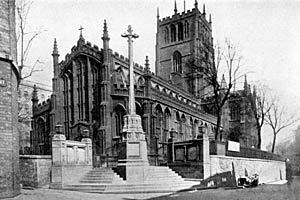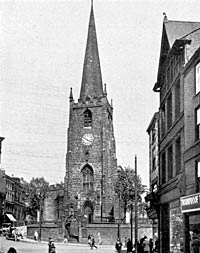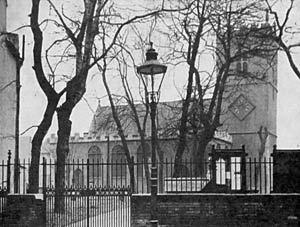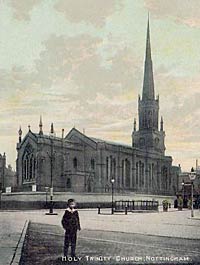< Previous | Contents | Next >

St Mary's church, Nottingham, in the early 1930s.
Of Nottingham's great group of churches and chapels only a few are old. In the heart of the Lace Market, crowning the hill which rises 90 feet above the low land which was once green meadows, rises the stately church of St Mary's, its tower ten feet higher than the top of the castle to which it looks across the city roofs. It rises 126 feet, with eight pinnacles, and is as old as the Tudor dynasty. The church is a splendid example of 15th century work and has impressive walls richly adorned with buttresses and panelled battlements. The south porch, weatherworn but still beautiful, has a panelled gable and a vaulted roof, the inner doorway set between canopied niches with the great head of a lion above it. Its splendid double doors are faced with bronze scenes in the life of Our Lord and the Madonna, and over the doors is a Pieta, a sorrowing dove withdrawing behind a veil to appear again as a joyful dove, symbolising the weary soul finding new life; the doors are of our own time, in memory of a vicar, Francis Morse, "Father, pastor, friend." Angels and flowers enrich the west doorway, which was put here when Sir Gilbert Scott restored the west end to its original style. Kings, bishops, and animals guard the windows on the north side. The fine panelled chimney of the old vestry is probably 17th century.
Except for the dim chancel, plainer than the rest of the building, the interior is full of light, the clerestory like a lantern with 12 great windows on each side. The lofty nave arcades have no capitals. Transepts open from the tower, whose massive pillars, 24 feet round, were twice rebuilt last century. The south transept is one of the oldest parts of the church; so, too, is the doorway in the north aisle, with crowned heads, probably those of Richard the Second and his queen; the old studded door still hanging in its original iron fastening led to a chantry. In the stone seats along the aisle walls are stones from the earlier church, and there is part of a very old pillar covered by a movable board in the floor by the north arcade. Round the 15th century font is the familiar Greek inscription which reads the same both ways, meaning: Wash thy sins and not thy face only. There are fragments of 16th century glass in the north transept, where is also a carved Jacobean altar table, and kept under glass in the south chapel is a beautiful fragment of alabaster of much interest. It shows a pope sitting under a canopy attended by two cardinals, and a kneeling bishop with his chaplains, and is said to represent Thomas Becket resigning the see of Canterbury. It was probably part of a medieval reredos. A rare treasure is a lovely Madonna and Child painted by Fra Bartolomeo, pupil of Raphael and friend of Savonarola.
Over 500 years ago John Samon left six-and-eightpence for a light to be kept burning for ever in a chapel here. He was four times Mayor of Nottingham and lies on his canopied tomb in the south transept, a civilian in a loose-sleeved coat buttoned from his collar to his feet. His pointed shoes rest on a dog, and battered angels support the cushion for his head. His son Richard, who died in 1427, has a battered floorstone near the north-west door, with his arms on the stem of a cross. In the north transept is a handsome canopied tomb seeming to have belonged to three memorials. The canopy, which has rich niches in its gable, covered the 15th century tomb of Thomas Thurland, who was nine times mayor and four times MP, and is remembered in Thurland Street. The alabaster tomb below the canopy, with carvings of the Madonna, Gabriel, Peter, and John the Baptist, and with a lily carved with a crucifix on its stem may be that of John Tannersley, another medieval mayor. The marble stone on the top of the tomb, which has lost its brasses, may be that of William Amyas, a wool merchant. On this triple tomb we found resting the memorial of still another mayor, Robert English, an alabaster fragment with a mitred figure on it. The battered figure in the north aisle may be his.
One of the memorials in the north transept to the Plumptres is an 18th century alabaster medallion to a boy of ten who was greatly learned in history and mythology, Latin and French, and has on his memorial these words from Virgil's Lament for Marcellus:
Over the shade of him who was my son
Heap I these gifts, and now my task is done.
There is another delightful epitaph in the north aisle on a tablet to Ann Hollings of 1770:
Rest, gentle shade, and wait thy Maker's will,
Then rise unchanged, and be an angel still.
Two great alabaster shields and an inscription now in the South transept are all that remain of the tomb of John Holles, the Earl of Clare, who fought against the Armada.
Near the pulpit is a floorstone to John Whitlock, who was in charge of St Mary's during the Commonwealth, and helped to found the Unitarian chapel on High Pavement. The great west window with 42 panels telling the story of Our Lord from the Manger to the Cross, is in memory of one of Nottingham's most famous citizens, the 19th century lace merchant, Thomas Adams; and the 19th century glass in the south transept, with the parables in 48 panels, is in memory of the founder of modern banking, Thomas Smith, who was buried here in 1699. An 18th century monument with an elephant's head is to another of the Smiths. In a north transept window are 16 panels of the Miracles. A pathetic window in the south chapel is in memory of Catherine Monica Dalton, who was baptised here in 1899 and died a week after her marriage here in 1918; we see her in the bridal gown and lace veil in which she was married and buried; she kneels before the Madonna, with St Catharine and St Monica standing by.
In the south aisle is the best glass in the church, a modern gallery of 24 saints, bishops, and kings, by Kempe; it keeps green the memory of the men of the Notts Regiment who fell in South Africa. A Scout window shows Scout badges, a knight in armour typifying courage, Christ with his arm on the shoulder of a pathfinder, a Scout setting out from home, and a camp-fire group in a field of bluebells. A window to the Notts veterans of the Crimean War and Indian Mutiny has for its theme: Young men shall see visions and old men shall dream dreams. The dull window in the chancel of Gethsemane, the Last Supper, and the Road to Calvary, is said to be designed by Sir George Frampton (though it does not look like it).
In the tower hangs a peal of ten bells, all having been recast except one, which comes from 1595; the last of the great Nottingham firm which cast it, and which sent so many bells round England, lies in the churchyard near the vestry, George Oldfield.
We may wonder if anywhere else in England is anything quite like the way in which Nottingham has remembered the men who did not come back from the war. It is one of two peace memorials at St Mary's, the other being a bronze panel in the chancel showing an officer leading his men up the line, with the Book of Remembrance below. What we believe to be a unique memorial is at one of the entrance gates to St Mary's, where, in the middle of a flight of steps, is a cross carved with furled flags round a shaft, and on the pedestal the name of every parish in the city and the number of men the parish lost; there are 5400. At each side of the steps are tablets with the names of the villages in the county and the number of men each village lost. There are 204 villages and towns and they lost 6912 men. Eight villages lost one man, ten lost two men, and eleven lost three. It is an admirable record in stone that the city has made for the county.

St Peter's church in the early 1930s.
St Peter's, a stone's throw from the Council House, is Nottingham's oldest church, with ten bells ringing in its 15th century tower, crowned by a lofty spire. One bell was given in 1544 by Margery Doubleday, a washerwoman, with 20 shillings a year to pay the sexton to ring it at four every morning to wake up the washerwomen of the future. The tower has a vaulted roof, and its slender arch frames a charming patch of colour in the west window with figures of Moses, Christ, Elias, Peter, James, and John.
The interior is spacious, stately, and light, with aisles divided from the nave by arches on clustered pillars. The south arcade is mostly 13th century with foliage and heads enriching some of the capitals. Some of the masonry in the wall of this arcade is said to have been part of a church built soon after the Conquest. The north arcade is 15th century, with loftier bays and embattled capitals, and faces between the arches. Some of the 15th century timbering is left in the roofs; in the nave the roof rests on stone angels and grotesques. At the top of the roodstairs is an old altar stone set up on end. The stone reredos has an angel setting Peter free from his chains, by Albert Toft.
On one of the pillars, under a rich golden canopy, is the lovely alabaster figure of St George, in armour with golden trappings and helmet, killing the dragon; it is the peace memorial. Three beautiful memorials brought here from St James's Church (lately pulled down) are a marble plaque to 16 men of the war, showing a youth in his last sleep, with winged angels watching; a bronze figure by Albert Toft of a woman with outstretched arms, in memory of a daughter; and a bronze plaque by Sir George Frampton to a vicar, Lawrence Wilkins. The modern oak screen, vaulted both sides, has 18 angels playing instruments and 12 cherubs singing in the tracery. A rare old treasure is the Guild Book of St George, with its beautiful handwriting of 500 years ago.

St Nicholas' church in the late 1930s.
Though the red brick church of St Nicholas has little claim to beauty, it has an interesting story. It was built in 1682 and enlarged in the next century, but it stands on a site where stood a Norman church. It was after the Royalists had bombarded the castle garrison from its tower that Colonel Hutchinson had the old building demolished. On the battlements is a great stone sundial.
St Andrew's 19th century stone church, standing well at the top of Mansfield Road by the Rock Cemetery and overlooking the Forest, has a tower with lantern and spire, and some fine modern craftsmanship inside. Two beautiful oak screens, one with fan-vaulting, are in memory of only sons lost in the war. Notable woodwork furnishes the chapel, where an alabaster tablet with two figures in niches keeps green the memory of others who did not come back. The rich panelling of the sanctuary and the lovely alabaster reredos were the gift of John and Margaret Player in 1918, "for 25 years of happy married life," the reredos showing in high relief Christ enthroned, a charming Nativity in which the ass and the ox peep over the stall, Christ walking with two disciples, the Baptism, Gethsemane, and the Resurrection with an angel and two sleeping soldiers.

Holy Trinity church, c.1910.
Holy Trinity Church in Milton Street, about a century old, is in 13th century style. It has lost much of the beauty it once had on its island site near the centre of the town, and is plain inside with galleries, but its needle-like spire, rising from the pinnacled lantern crowning the tower, is conspicuous in views of the city. All Saints in Raleigh Street comes from 1864, its tower surmounted by a sturdy broached spire, its apsidal chancel gabled on every face. The Roman Catholic Cathedral of St Barnabas on Derby Road, designed by Pugin in 13th century style, comes from 1842, its tower and spire rising to 170 feet from the middle of a cross. Opposite is the Albert Hall, the headquarters of the Wesleyan Mission; built in 1909, it has room for 2600 people, and has a magnificent organ given by the first Lord Trent.
St Catharine's Church stands in a workaday part of the city on St Ann's Well Road, and was built of stone in 1896 in place of an iron church whose length led local people to call it the "shooting gallery." One of its treasures is the font, with a rough-hewn bowl coming from Norman days, set on a medieval base. It belonged to the ruined church of South Wheatley near Retford, and while here it has served at over 3000 baptisms. The lectern is a pelican, its long legs hidden in the wooden pedestal. The crucifix in the lady chapel was carved by the peasants of Oberammergau. In the Children's Corner we come upon the memory of a family which has done much for this church. When he died in 1926 John Sargent had been St Catharine's only verger, and here is his grandfather clock and his table. The old sexton, his wife, and his daughter all died in one week. The daughter had for many years helped him to clean the church, and she left £20 to the hospital, and to the church £50, to be spent on a window to the patron saint. Here it is in the Children's Corner, in the spot she chose for it. Below the figure of St Catharine we see Alice Sargent kneeling on her scrubbing mat, her bucket, soap, and brush beside her, a tribute to one who looked on work as a holy thing. Under the window is a prayer desk she used in her home. With part of the money John Sargent left, new hymn books, hangings, and many things needful were bought for the church.
High Pavement's Unitarian chapel is a pleasing stone building of 1876, with a tower and a lofty spire, and an arcaded interior. It was founded by John Whitlock (who lies in St Mary's), William Reynolds, and John Barnet, the first two joint-ministers of St Mary's during the Commonwealth. Three memories of the older chapel are of Samuel Taylor Coleridge preaching a charity sermon in 1796, of Byron coming here as a boy, and of the baptism of Richard Parkes Bonington in 1802. Its great interest is in its beautiful glass. The seven-light window facing south has a splendid gallery of 21 graceful figures in three rows by Burne-Jones, shining red, blue, green, and gold on a background of foliage. Row One shows Truth with a torch, Light, Faith, Love, Hope, Joy, Peace. Row Two has Justice with the sword and scales, Courage staving off darts with a shield, Reverence beside a figure of Jesus with four children, Mercy with hands on a sword, Purity, and Humility carrying a lamb. Row Three has Science, Literature, Theology, Labour, Philanthropy, Art, and Theosophy. Another window full of light and colour, in memory of war heroes, shows a soldier and a sailor with bowed heads and arms reversed, knights in armour, a man with a plough, an angel above him putting away the sword; Joan of Arc with a Scout and a workman and women; St George with children, women, soldiers, and sailors; and a mother and her children mourning by a wooden cross. A Kempe window with St George and Sir Galahad is to two men who did not come back.
Another nonconformist church of note is Castle Gate Congregational, the oldest chapel in Nottingham, founded in Cromwell's day, and the first church in the city to be wired for broadcasting.
